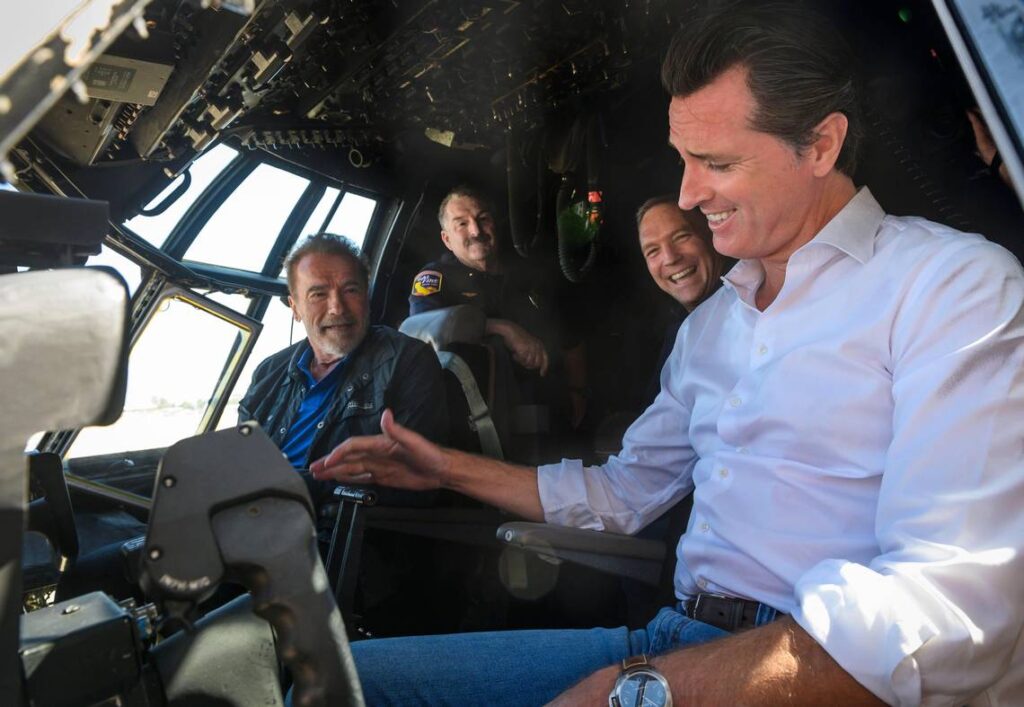
California Gov. Gavin Newsom, right, and former Gov. Arnold Schwarzenegger talk in a C-130 airplane cockpit with Cal Fire personnel at McClellan Airport near North Highlands in 2019. (Daniel Kim/The Sacramento Bee/TNS)
The state and its fire protection agency will have to get them into shape, but the first of the seven C-130 aircraft could be in service by the end of 2024 when President Joe Biden signs the bill into law.
Ken Pimlott, now-retired Cal Fire chief who worked with late Sen. Dianne Feinstein and others to get the planes, summed up his feelings in one word: “Elated.”
“We should celebrate the efforts of so many people and folks, taking a moment to reflect on how important and what an opportunity was accomplished today,” Pimlott said, “and obviously not taking our eyes off the ball.”
Five years ago, Congress told the U.S. Air Force to convert seven surplus Coast Guard aircraft into firefighting tankers for California’s fire protection agency. A series of delays caused by the pandemic, contracting issues and construction hurdles prevented the job from being completed.
Sen. Alex Padilla, D-Calif., Rep. Ken Calvert, R-Corona, and Sen. John Boozman, R-Ark., inserted a provision in a 2024 defense spending bill to send the C-130 aircraft to California immediately — done or not. Congress passed the National Defense Authorization Act Thursday, and Biden is expected to sign it.
“These are aircraft that can mobilize quickly and attack wildfires to better protect our communities,” said Gov. Gavin Newsom, who also helped get the planes. “This was a collaborative effort with our partners Sen. Padilla, the late Sen. Feinstein, and others to deliver for Californians.”
What will the firefighting planes do?
Cal Fire, the California Department of Forestry and Fire Prevention, currently has 65 aircraft in use, making it the world’s largest civil firefighting fleet. That includes 23 S-2T air tankers, which can hold 1,200 gallons of fire retardant. C-130s — giant four-engine turboprops traditionally used for transport and aerial refueling — can carry up to 4,000.
Fire retardant is used around the fire perimeter to slow its spread. Its effectiveness depends on winds, weather and terrain, but firefighters rely on it to quickly contain blazes.
Cal Fire is expected to retrofit and add the C-130 aircraft to its fleet up and down the state, the first of which should be in the air in the fourth quarter of 2024, a spokesman said. Pimlott said the additional aircraft would be a great aid in the initial containment of a fire, and in the event of continued spread.
“When those fires do escape initial attack because conditions, et cetera, that are causing that,” Pimlott said, “now you’ve got an aircraft that can be put in the mix as you need additional aircraft and provide more retardant to strategically put-in containment lines — you can do that more efficiently, more quickly.”
Delays in converting the aircraft
The Air Force was originally charged with updating these aircraft nearly a decade ago: Under a 2014 spending mandate, the surplus Coast Guard planes were supposed to go to the U.S. Forest Service.
Years of delays and rising cost estimates led the Trump administration in late 2017 to scrap the idea. Congress in 2018 directed that the planes go to California, which had a robust firefighting fleet and worsening wildfire seasons.
The soonest planes were expected to get to California was 2021, Roll Call reported at the time. But a fresh round of delays — caused by the pandemic and often glacial federal contracting procedures — prolonged the wait.
No longer, Padilla said: “While it has been a frustrating few years, ecstatic that these C-130s will be in the right hands soon and helping respond to wildfires very, very soon.”
Wildfire seasons in California
California has seen some of the largest, deadliest and most expensive wildfires in the state’s history in recent years. The 2021 Dixie Fire was the largest; the 2018 Camp Fire was its deadliest.
This season, following a winter with atmospheric rivers and historic rain, was mild, as was 2022. But that trend won’t last, according to experts. Warmer global temperatures indicate wildfires could become more common and severe.
“It is absolutely recognized that 2023 was a modest fire season,” said Matt Dias, CEO of the California Forestry Association, a trade coalition for the state’s forestry sector, “but to be clear, we are still in the midst of a wildfire crisis.”
“When we have lives at risk, when we have communities at risk, we have to have the strongest all-hands-on-deck approach to suppression,” he added, “so that the private lands, the communities, our resources, our public trust resources are all being treated as such.”
____
©2023 The Sacramento Bee. Visit at sacbee.com. Distributed by Tribune Content Agency, LLC.




